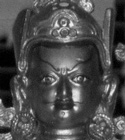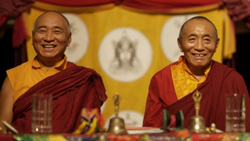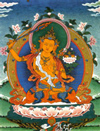
One of the core Tibetan Buddhism Beliefs: Padmasambhava, pictured here in this statue, is considered to be the founder of Tibetan Buddhism.
To read about the Master, Click Here
Tibetan Buddhist Beliefs: The Vajrayana
The basic difference between Tibetan Buddhist beliefs and other Buddhist traditions would be cultural, since Tibet is a most unique land untainted by outside influences for centuries due to its remote geographical location.As a practitioner of The Vajrayana for more than twenty years, I would say that Tibetan Buddhism is quite powerful and rich in ritual, color and cosmological mythology and symbology. It is the most sophisticated, complex type of Buddhism, and in my opinion, the most complete.
Vajra is Sanskrit for diamond, (meaning indestructible); yana, Sanskrit for path. Hence, Tibetan Buddhism is known as The Diamond Way or The Diamond Path.
This topic, Tibetan Buddhism beliefs, is quite a large discussion which requires a number of basic Buddhist beliefs to be covered as an overview to help facilitate an understanding of such a fascinating subject.

As mentioned in my prior page, the Buddha's teaching (Dharma) came to Tibet directly from India (not through China as other Mahayana branches did). To read about that Click Here Therefore, most scholars agree that Tibetan Buddhism beliefs and practices are a hybrid of Mahayana and Theravada schools including a unique weaving of Tantra. Sometimes Tibetan Buddhism is actually called The Tantrayana. Tantra is Sanskrit for weaving, and sometimes is translated as continuum; yana, as I mentioned earlier, is path.
The Tibetan tradition is the last of The Buddha's teachings, or the most 'recent' branch of it. Now that Buddhism has spread to the West, it will be interesting to see how the teachings (Dharma) merge, blend and integrate with American culture in the forthcoming centuries.
Tibetan Buddhist Beliefs: Bodhisattva & Lineages
One of the most important Tibetan Buddhism beliefs is in the great Bodhisattva. Bodhi is Sanskrit for awakened wisdom, and sattva is a Sanskrit word that means being, or essence.As Tibetan Buddhist practitioners, cultivating the mind for enlightenment to help others is what the ultimate aspiration is. One actually takes a vow, The Bodhisattva Vow, to help all sentient beings to become enlightened, for the benefit of all. I have personally taken this vow three times.
In other words, it is not enough to become enlightened. Yes, that achievement is wonderful, however, the Bodhisattva vows to help all sentient beings to become enlightened, too--however long that takes!

...One of the beliefs of Buddhism: All beings are sacred.
The essential Tibetan Buddhist beliefs include practicing (meditation methods) for the sake of all sentient beings. Developing loving kindness, compassion and wisdom is the cornerstone of this philosophy. It doesn't matter what specific lineage of Tibetan Buddhism is practiced; they are not sects, which imply differing views. All schools have the same beliefs of Buddhism.
Lineages: The four main schools of Tibetan Buddhism are:
- Nyingma (the oldest lineage teachings from Padmasambhava)
- Shakya
- Kagyu
- Geluk (the lineage of His Holiness the Dalai Lama)
There is also the Kadam school (the Kadampas) which is sometimes considered the fifth lineage of Tibetan Buddhism.
Tibetan Buddhist Beliefs: Lama, & Deity Yoga
One of the core Tibetan Buddhism beliefs is the importance of the Lama. I know you've heard of the Dalai Lama, yes? Lama is a Tibetan word for guru, which is Sanskrit. Guru basically means "one who removes the darkness." When studying Tibetan Buddhism it is essential to know the 3 Jewels. To learn about "The Triple Gem"...Click Here Dzogchen Master, Khenchen Palden RinpocheI have been blessed for many years to sit at the feet of two Lamas, Masters of Tibetan Buddhism, stainless upholders of the Nyingma Lineage. They are brothers, known affectionately as The Venerable Khenpos.
Dzogchen Master, Khenchen Palden RinpocheI have been blessed for many years to sit at the feet of two Lamas, Masters of Tibetan Buddhism, stainless upholders of the Nyingma Lineage. They are brothers, known affectionately as The Venerable Khenpos.His Eminence, Khenchen Palden Sherab Rinpoche, (seated right in the photo) offers Transmissions and Empowerments of the sacred teachings in an unbroken oral lineage from the time of Padmasambhava in the eighth century AD. His younger brother, Khenpo Tsewang Dongyal Rinpoche, (left in photo) translates.
It is said in Tibet that a student should take twelve years to discern if a Lama is their "spiritual friend." This is a Buddhist term for a mentor, or a spiritual teacher. As I mentioned before the culture of Tibet is quite unique. The relationship of the Lama and student is very key in The Vajrayana. Besides meditation advice and instruction, the Lama gives the "permission," the Wang, or Abisheka (empowerment/initiation) for Deity practices.
Deity Yoga is one of the most fundamental Tibetan Buddhism beliefs. The goal is to recognize (re-cognize, re-know, re-member) that one's own mind is inherently Buddha Mind.
Just below is a Thangka painting (Tibetan iconographical art) of Manjushri, embodying the Wisdom of all Buddhas. This is an example of Deity Yoga. You visualize yourself merging with Manjushri...you ARE Manjushri. Meditate on the ultimate primordial nature of wisdom as nondual reality.
One of the core Tibetan Buddhism Beliefs: Your mind is Buddha Mind.

This brief discussion on Tibetan Buddhism beliefs and practices has just barely scratched the surface of a vast and complex subject which I hold dear to my heart of hearts.
There is so much more to explore such as Tibetan Mantras, Chakras, the Sutras vs. the Tantras and the great completion, Dzogchen.
Thank you for visiting today. I trust you may have gained some insight into the powerful Vajrayana, The Diamond Way.
As a long-time practitioner I will say that it is important to study the basic beliefs of Buddhism, yet we must practice,too. So, get on the cushion--your meditation pillow--and proceed.
Since one of the biggest Tibetan Buddhism beliefs is the emphasis on practicing meditation, this helps guide us to maintain the VIEW. What is this vision? Keep your "360" view spacious in all directions. Keep the Vajra View. Like Guru Padmasambhava, the Lotus Born, the great Guru Rinpoche (precious one) taught so long ago in the Root Prayer of the Six Bardos:
"...enter into the natural sphere of unwavering attentiveness..."END=OM MANI PADME HUM.( 3 TIMES ).RESEARCH BUDDHIST TIBET DHARMA BY BIKKHUNI GESHE TESERING TASHI.OM MANI PADME HUM.5/2/2012.
No comments:
Post a Comment